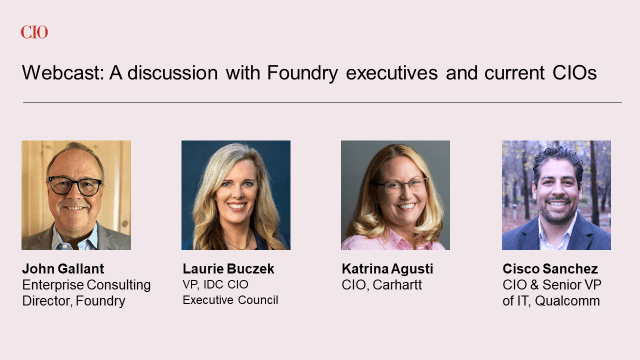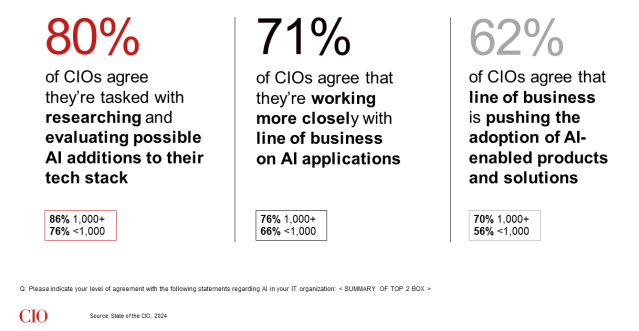
Selling to the CIO
Voices of the CIO
Each year, the State of the CIO study outlines how the role of the CIO continues to evolve in today’s business climate, and explores their business and tech initiatives as they navigate the impact of the current economic climate.
To highlight key parts of the 2024 State of the CIO research and to hear voices of the CIO, Foundry partnered with IDC/CIO Executive Council for a discussion, hosted by John Gallant, enterprise consulting director at Foundry and Laurie Buczek, Research Vice President of IDC. They were joined by Katrina Agusti, CIO of Carhartt and Cisco Sanchez, Senior IT Vice President & CIO at Qualcomm.
This far-ranging conversation covers:
- Tech budgets
- If and how the tech purchase process is changing
- How the CIO is becoming a changemaker
- CIOs current and future focuses
- Earning the right to innovate
- Partnering with line of business on AI initiatives
- And more.
Below are some highlights from the conversation as well as a condensed video – watch the full 2024 State of the CIO webcast to hear much more from our CIO guests, and the key points from the State of the CIO research.
What are CIOs saying about technology budgets?
Technology has proven to be a constant necessity in order to drive the business forward, and CIOs are not largely concerned with their technology budgets being reduced. In fact, 89% of CIOs expect their tech budget to either increase or remain the same this year.
Cisco noted that the bounce back after the pandemic may be contributing to this growth. “I think what we’re seeing at least in the market now is we’re coming out of this economic downturn, we’re seeing the kind of the world back come back and respond.”
Katrina followed up by saying that these results absolutely resonate with Carhartt. She continued to say that “most organizations are seeing the technology as an unlock to help manage expenses in other parts of the organization through operational efficiency.” and therefore leading to increased technology budgets.
How do CIOs think the tech purchase process is changing?
John prompted the CIOs to find out if and how the technology purchase process is changing from their perspective. Specifically, what are they seeing when they are buying and acquiring new technologies? Is it taking longer? Are there more people involved?
Katrina sees that there’s more diligence around the business case and an overall return on investment. “I will say in times of uncertainty, there’s always additional rigor on all spend within the organization over certain thresholds. So you know we are seeing a little more scrutiny, but again as I mentioned earlier, knowing that IT is an investment that can drive operational efficiencies throughout the organization, I think we continue to make the investments.”
Cisco continues to note that the purchase process is actually going faster. “It sounds weird, but we’re actually going faster and in a lot of cases and the approvals are going a lot quicker because of the stuff we are trying to enable has a sell by date that we have to hit.”
This quickness does not mean that vendor-buyer relationships are negatively impacted. Cisco states he doesn’t want the relationship to be solely transactional.
“I don’t want it to be a transactional discussion. I do like the interaction and collaboration and alignment…there are deeper relationships that we want to create because there may be a favor one day that we might need to ask one day so I think we are also trying to manage that.”
Are CIOs being viewed as a changemaker?
According to the research, 85% of CIOs view themselves as a changemaker, increasingly leading business and technology initiatives. To further solidify this statement, 82% of line of business executives agree.
When asked if she views herself as a changemaker and what being a changemaker means to her, Katrina had a powerful response to her role.
“I’ve had the opportunity to start to lead the transformation office at Carhartt. So being able to have a seat at the table to really drive and shape the strategy and direction of the organization and help enable that through, you know, digitization and innovation is just amazing.”
She continues to say “And what it means to be a change maker at Carhartt is really, you know, the education, the advocacy to see the assessment of the readiness and capability of the organization and setting them up for success in the change journey.”
Cisco agrees as well and thinks it is time for the CIO to embrace that role. “I think it is important that we start to embrace that role and not just say got it, I’ll plug it in, it’s no what is this and why and how come and well we have four of them, we don’t need it anymore.”
“I think what it means for me to be a change maker, it’s still partnership with the business, understanding your business, all lines of business understanding their goals and missions understanding where the unique is and where the common is. I think when we start to do that, we can enable new capabilities to help drive additional change and new feature sets that the business frankly may not have known that we could have done.”
Is there a gap between current and future CIO responsibilities?
When CIOs were asked about their current day-to-day focus in this year’s study, the top four responses are all operationally focused – security management, improving IT operations, aligning IT initiatives with business goals, and modernizing infrastructure. However, when looking to the future, the mix of priorities changes. In the next one to three years, CIOs report that they hope to spend their time driving business innovation and redesigning business processes.
This gap in current versus future focus is understood by Sanchez who notes that you have to set yourself up appropriately to be invited to the party. “There’s always blocking and tackling that has to occur just to run your job. If you’re not achieving operational excellence, you don’t get invited to anything else. If you can’t do your job, you won’t be invited to the party.”
“You can’t help innovate if you’re just running, so I think there’s aways that component of we now got to a point where operational excellence is really good, and now there is opportunity to innovate and change. So I think the reason for the gap is making sure the structure is perfect, you’re banking enough points to say all of these components are running really well, now let’s go innovate.”
Katrina agrees as she says “I think that you first have to focus on the foundation. So as you go through and modernize the different elements of your infrastructure and ecosystem, and also address technical debt, you can start to leverage technology through automation and be more proactive, which will help you start to shift some of that time commitment. So I think stabilization and kind of getting your house in order first so that you can shift that time commitment would be top priority.”
Are CIOs effectively working with line of business around AI?
Although AI has been used by organizations for decades, it is a tool set and technological advance that is high on organizations’ radar since the addition of Gen AI. The 2024 State of the CIO research found that 80% of CIOs anticipate they will become more involved with AI/machine learning in the next year, which is up from 55% in 2023.
Seventy-one percent of CIOs also agree that they’re working more closely with line of business on AI applications, especially as LOB is pushing the adoption of AI-enabled products and solutions. This creates a huge opportunity for the CIO, but the first step is education.
From Katrina’s perspective, “CIOs must educate on potential business use cases, where we’re seeing value, and then of course where we’re already using it, where we see opportunity. And then educating them on some of the key considerations of using AI responsibly and what that could mean to our organization. You know, we have to be the risk assessor, we have to call out the risk, so it’s a well-rounded education campaign where we share the good and the bad. We are definitely having a free flow exchange with our line of business partners and leveraging our technology partners to help us educate.”
Cisco supports this and then goes further to say that the education is sometimes the easiest part. “It’s then the rollout and making sure that we don’t have too much of the similar tool sets that sometimes get pushed to say here’s another one, and another one. We have to say, no we already have that one. So I think it’s more of ensuring that we identify what are those use cases and how to leverage them.”
With this data and the undeniable emergence of AI in mind, Laurie Buczek offers her key takeaway to CIOs. She urges them to take advantage of this moment – “I feel like we’re at a very different change that’s really going to necessitate the CIO to come in and help to educate the business on the opportunities, to also do the proper risk mitigation.”
Laurie later goes on to say “This is truly a moment for CIOs. We are at a pretty major inflection point with technology driving an acceleration in our ability to innovate and it is really changing the business, so this is the time for CIOs to rise up to be a business leader of how technology can really support the business.”
What other roles exist with the CIO?
One question in the State of the CIO research asks if any other “Chief” titles exist within the IT department. If these roles such as a Chief AI Officer, Chief Digital Officer, or Chief Innovation Officer, exist, what does the reporting structure look like? Are they a threat to the CIO? Are they an evolution of the CIO roles? Our CIO guests have some input.
Cisco addresses this by saying “There’s a need for certain types of technology, but the greatest thing I think about the CIO role is the Chief Integration Officer, that it does the integration for technology. It’s either data, ML, AI, etc. but essentially the CIO is helping to form and identify that because you probably have to secure it if you build something and you probably have to scale it, which all rolls into the CIO role.”
“I think if you start to label it takes away from the essence of the CIO role and then there’s counterbalance and integration has to happen. So I don’t think it should be a separate role outside of the CIO area because then it’s a little bit dangerous of creating a technology group outside of the technology group.”
Katrina replies, “We’re not really the size of an organization that requires to have multiple chief titles within technology, so today we only have the Chief Information Officer, and obviously we have disciplines within the organization that represent each one of these areas in IT, but they don’t have the chief title.” It ultimately comes down to the maturity and size of your organization.
Resources
Learn how CIOs are spending their time and prioritizing certain initiatives.
